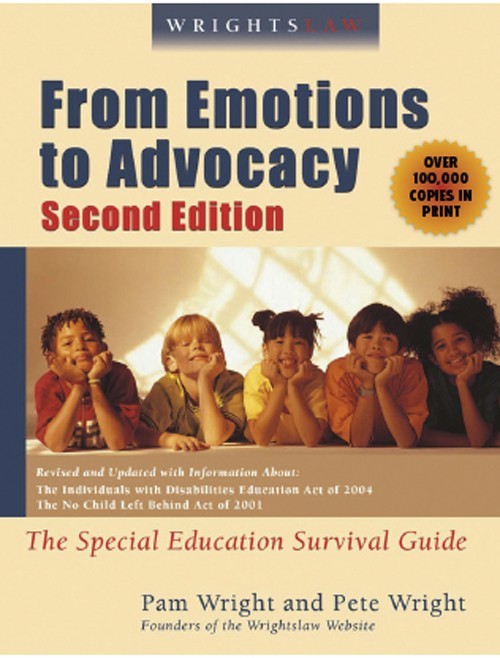Getting Started
“A good education is the next best thing to a pushy mother.” – Charles Schulz, cartoonist
Good special education services are intensive and expensive. Resources are limited. If you have a child with special needs, you may wind up battling the school district for the services your child needs. To prevail, you need information, skills, and tools.
“On your journey from emotions to advocacy, you will learn about your child’s disability, educational and remedial techniques, educational progress, Individualized Educational Programs (IEPs), and how to artfully advocate.”
“You will learn how to present your concerns and problems in writing, prepare for meetings, and search for win-win solutions. You will learn how to use your emotions as a source of energy and power, and how to focus on getting an appropriate education for your child.” (From Wrightslaw: From Emotions to Advocacy – The Special Education Survival Guide by Pam and Pete Wright).
Resources by Chapter
Section Four teaches you about special education law.
 Scales As the parent of a child with a disability, you need to learn how to do legal research. If the school says, “The law says we cannot do what you ask us to do,” you need to research the issue independently. After you read the statute, the regulation, and a case or two, you will know what the law says the school can and should do. Knowledge gives you power.
Scales As the parent of a child with a disability, you need to learn how to do legal research. If the school says, “The law says we cannot do what you ask us to do,” you need to research the issue independently. After you read the statute, the regulation, and a case or two, you will know what the law says the school can and should do. Knowledge gives you power.
To understand a legal issue, you should study three types of law:
* Statutory law
* Regulatory law
* Judicial decisions, also known as case law
Read the statute first. Next, read the federal regulation and your state regulation. The regulation usually expands on the statute. Then, read cases that interpret your issue. After you read the statute, regulations, and cases, you will understand the law about your issue.
Do not rely on legal advice provided by school personnel or articles written by others.
You must read the law. In the beginning, this is more difficult than having the law interpreted for you. As you read, the law will begin to fit together in your mind. When you know how the law is organized, you can find sections or regulations that are relevant to your situation.
 In Section Four, you learned about special education law. In Section Five, you will learn how to use tactics and strategies to anticipate problems, negotiate for services, and avoid crises.
In Section Four, you learned about special education law. In Section Five, you will learn how to use tactics and strategies to anticipate problems, negotiate for services, and avoid crises.
If you have a dispute with the school, tactics and strategies will help you influence the outcome.
In “The Rule of Adverse Assumptions,” we describe the assumptions you must make and how preparing for conflict helps you avoid conflict. You will learn about proof and evidence, and how to present your case.
In “Creating Paper Trails,” you learn how to use logs, calendars, and journals to create paper trails. When you train yourself to write things down, you are taking steps to protect your child’s interests.
Because letter writing is essential to effective parent advocacy, Wrightslaw – From Emotions to Advocacy, 2nd Edition includes two chapters about writing letters to the school.
You will learn about the purposes of letters and strategies you can use to ensure that your letters accomplish their purpose. You will learn editing and presentation techniques that will enhance the effectiveness of your letters.

 In Section Four, you learned about special education law. In Section Five, you will learn how to use tactics and strategies to anticipate problems, negotiate for services, and avoid crises.
In Section Four, you learned about special education law. In Section Five, you will learn how to use tactics and strategies to anticipate problems, negotiate for services, and avoid crises.

